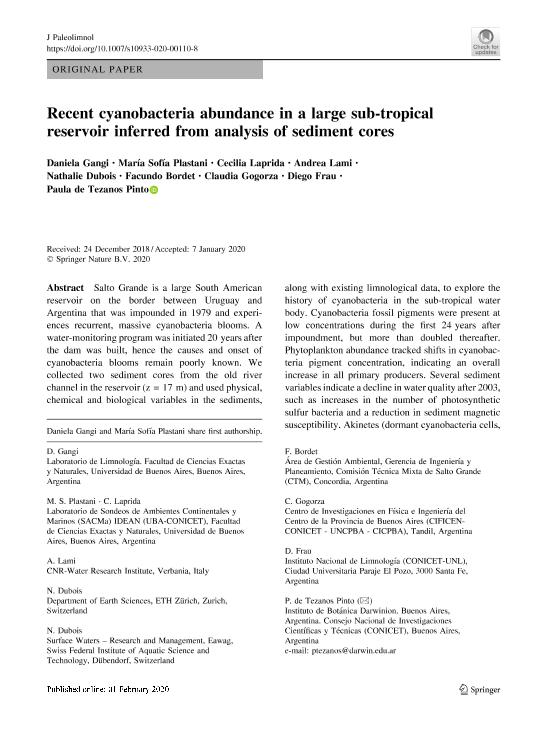Mostrar el registro sencillo del ítem
dc.contributor.author
Gangi, Daniela
dc.contributor.author
Plastani, María Sofía

dc.contributor.author
Laprida, Cecilia

dc.contributor.author
Lami, Andrea
dc.contributor.author
Dubois, Nathalie
dc.contributor.author
Bordet, Facundo
dc.contributor.author
Gogorza, Claudia Susana

dc.contributor.author
Frau, Diego

dc.contributor.author
de Tezanos Pinto, Paula

dc.date.available
2021-07-30T14:30:49Z
dc.date.issued
2020-02
dc.identifier.citation
Gangi, Daniela; Plastani, María Sofía; Laprida, Cecilia; Lami, Andrea; Dubois, Nathalie; et al.; Recent cyanobacteria abundance in a large sub-tropical reservoir inferred from analysis of sediment cores; Springer; Journal Of Paleolimnology; 63; 3; 2-2020; 195-209
dc.identifier.issn
0921-2728
dc.identifier.uri
http://hdl.handle.net/11336/137444
dc.description.abstract
Salto Grande is a large South American reservoir on the border between Uruguay and Argentina that was impounded in 1979 and experiences recurrent, massive cyanobacteria blooms. A water-monitoring program was initiated 20 years after the dam was built, hence the causes and onset of cyanobacteria blooms remain poorly known. We collected two sediment cores from the old river channel in the reservoir (z = 17 m) and used physical, chemical and biological variables in the sediments, along with existing limnological data, to explore the history of cyanobacteria in the sub-tropical water body. Cyanobacteria fossil pigments were present at low concentrations during the first 24 years after impoundment, but more than doubled thereafter. Phytoplankton abundance tracked shifts in cyanobacteria pigment concentration, indicating an overall increase in all primary producers. Several sediment variables indicate a decline in water quality after 2003, such as increases in the number of photosynthetic sulfur bacteria and a reduction in sediment magnetic susceptibility. Akinetes (dormant cyanobacteria cells, Order Nostocales) in recent reservoir deposits were abundant and five species germinated under laboratory conditions, underscoring the ability of akinetes to initiate cyanobacteria blooms. The germinated assemblage reflected closely the composition of cyanobacteria blooms in the reservoir. Recorded increases in air temperature and decreases in wind speed, together with other variables (e.g. nutrients), can promote the large, recurrent cyanobacteria blooms. Invasion of the bivalve Limnoperna fortunei apparently promoted cyanobacteria blooms by preferential feeding on other phytoplankton taxa, and perhaps by altering nutrient concentrations and ratios. This work highlights the potential for using multiple variables in sediment cores from large reservoirs to better understand the responses of biota to multiple environmental stressors.
dc.format
application/pdf
dc.language.iso
eng
dc.publisher
Springer

dc.rights
info:eu-repo/semantics/openAccess
dc.rights.uri
https://creativecommons.org/licenses/by-nc-sa/2.5/ar/
dc.subject
AKINETES
dc.subject
CYANOBACTERIA
dc.subject
PALEOLIMNOLOGY
dc.subject
PIGMENTS
dc.subject
RESERVOIR
dc.subject.classification
Otras Ciencias de la Tierra y relacionadas con el Medio Ambiente

dc.subject.classification
Ciencias de la Tierra y relacionadas con el Medio Ambiente

dc.subject.classification
CIENCIAS NATURALES Y EXACTAS

dc.title
Recent cyanobacteria abundance in a large sub-tropical reservoir inferred from analysis of sediment cores
dc.type
info:eu-repo/semantics/article
dc.type
info:ar-repo/semantics/artículo
dc.type
info:eu-repo/semantics/publishedVersion
dc.date.updated
2021-02-10T21:06:01Z
dc.journal.volume
63
dc.journal.number
3
dc.journal.pagination
195-209
dc.journal.pais
Alemania

dc.journal.ciudad
Berlin
dc.description.fil
Fil: Gangi, Daniela. Universidad de Buenos Aires. Facultad de Ciencias Exactas y Naturales; Argentina
dc.description.fil
Fil: Plastani, María Sofía. Consejo Nacional de Investigaciones Científicas y Técnicas. Oficina de Coordinación Administrativa Ciudad Universitaria. Instituto de Estudios Andinos "Don Pablo Groeber". Universidad de Buenos Aires. Facultad de Ciencias Exactas y Naturales. Instituto de Estudios Andinos "Don Pablo Groeber"; Argentina
dc.description.fil
Fil: Laprida, Cecilia. Consejo Nacional de Investigaciones Científicas y Técnicas. Oficina de Coordinación Administrativa Ciudad Universitaria. Instituto de Estudios Andinos "Don Pablo Groeber". Universidad de Buenos Aires. Facultad de Ciencias Exactas y Naturales. Instituto de Estudios Andinos "Don Pablo Groeber"; Argentina
dc.description.fil
Fil: Lami, Andrea. Centre National de la Recherche Scientifique; Francia
dc.description.fil
Fil: Dubois, Nathalie. No especifíca;
dc.description.fil
Fil: Bordet, Facundo. No especifíca;
dc.description.fil
Fil: Gogorza, Claudia Susana. Universidad Nacional del Centro de la Provincia de Buenos Aires. Centro de Investigaciones en Física e Ingeniería del Centro de la Provincia de Buenos Aires. - Consejo Nacional de Investigaciones Científicas y Técnicas. Centro Científico Tecnológico Conicet - Tandil. Centro de Investigaciones en Física e Ingeniería del Centro de la Provincia de Buenos Aires. - Provincia de Buenos Aires. Gobernación. Comisión de Investigaciones Científicas. Centro de Investigaciones en Física e Ingeniería del Centro de la Provincia de Buenos Aires; Argentina
dc.description.fil
Fil: Frau, Diego. Consejo Nacional de Investigaciones Científicas y Técnicas. Centro Científico Tecnológico Conicet - Santa Fe. Instituto Nacional de Limnología. Universidad Nacional del Litoral. Instituto Nacional de Limnología; Argentina
dc.description.fil
Fil: de Tezanos Pinto, Paula. Consejo Nacional de Investigaciones Científicas y Técnicas. Instituto de Botánica Darwinion. Academia Nacional de Ciencias Exactas, Físicas y Naturales. Instituto de Botánica Darwinion; Argentina
dc.journal.title
Journal Of Paleolimnology

dc.relation.alternativeid
info:eu-repo/semantics/altIdentifier/url/http://link.springer.com/10.1007/s10933-020-00110-8
dc.relation.alternativeid
info:eu-repo/semantics/altIdentifier/doi/http://dx.doi.org/10.1007/s10933-020-00110-8
Archivos asociados
